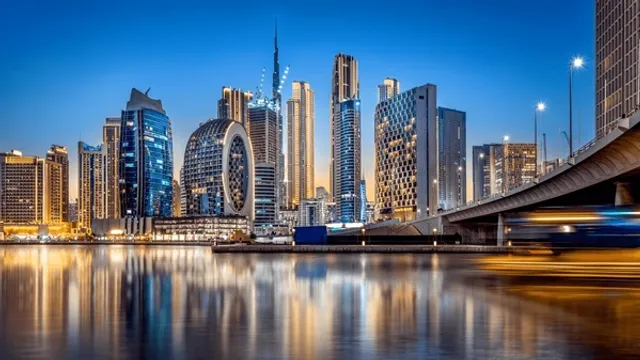Introduction
Dubai, a name synonymous with luxury, modern architecture, and futuristic innovation, is one of the most famous cities in the world. But where exactly is Dubai located? What makes its geography unique? This guide will provide an in-depth look at Dubai’s location, its geographical features, and how they contribute to its development and global significance.
Where Is Dubai Located?
Dubai is one of the seven emirates that form the United Arab Emirates (UAE), a country situated on the Arabian Peninsula in the Middle East. It lies along the southeastern coast of the Persian Gulf, bordered by the emirates of Abu Dhabi to the south, Sharjah to the northeast, and the vast desert landscape of the UAE extending to its east. The geographical coordinates of Dubai are approximately 25.276987° N latitude and 55.296249° E longitude.
Dubai’s Location Within the UAE
Dubai is the second-largest emirate by area after Abu Dhabi, covering approximately 4,114 square kilometers (1,588 square miles). It is strategically positioned between Europe, Asia, and Africa, making it a crucial global business and tourism hub. Where Is Dubai, the emirate’s capital, is located centrally along the coastline and is home to some of the world’s most iconic landmarks.
Neighboring Countries and Proximity to Other Major Cities
Dubai is strategically close to several key locations:
- Saudi Arabia: Located to the west and south of the UAE, with major border crossings connecting the two nations.
- Oman: Situated to the southeast, with a shared border that provides access to mountainous terrains and coastal cities.
- Iran: Although separated by the Persian Gulf, Iran is directly across the water from Dubai, making maritime trade between the two regions significant.
- Doha, Qatar: Around 375 kilometers (233 miles) from Dubai, with direct flight connections making travel easy.
- Riyadh, Saudi Arabia: Approximately 990 kilometers (615 miles) away, accessible by air or road.
- Muscat, Oman: Located about 450 kilometers (280 miles) from Dubai, a common travel route for tourists.
Geographic Features of Dubai
Dubai’s geography is a blend of coastal, desert, and urban landscapes. Here’s a closer look at its key geographical features:
1. Coastline and Waterways
Dubai’s western border is defined by its coastline along the Persian Gulf, stretching approximately 72 kilometers (45 miles). The city is home to natural and man-made water features, such as:
- Dubai Creek: A natural saltwater inlet dividing the city into two main areas, Deira and Bur Dubai.
- Palm Jumeirah and Palm Jebel Ali: Artificial islands shaped like palm trees, contributing to Dubai’s coastline expansion.
- The World Islands: A collection of artificial islands designed to resemble a world map.
2. Desert Landscape
Dubai’s interior consists of vast desert areas that are part of the Arabian Desert. The desert terrain includes sand dunes, gravel plains, and occasional oases. The sand is mostly fine and reddish due to the presence of iron oxide. Popular desert attractions include:
- Al Marmoom Desert Conservation Reserve: A protected area home to native wildlife.
- Dubai Desert Conservation Reserve: A vast protected desert habitat offering eco-tourism experiences.
- Al Faya Desert: Famous for its picturesque sand dunes and adventure activities like dune bashing.
3. Mountains and Hajar Range Proximity
Though Dubai itself is mostly flat, it is relatively close to the Hajar Mountains, which run along the UAE-Oman border. The mountains influence the climate and provide hiking opportunities.
Climate and Weather in Dubai
Dubai experiences a hot desert climate characterized by:
- Extremely hot summers: Temperatures can reach 45°C (113°F) or higher from June to September.
- Mild winters: From November to March, temperatures range between 14°C (57°F) and 26°C (79°F), making it the best time for tourism.
- Low annual rainfall: Rain is infrequent, occurring mainly in the winter months.
- High humidity levels: Due to its coastal location, humidity can exceed 90% in summer.
How Dubai’s Geography Impacts Its Growth
Dubai’s strategic location and unique geography have played a significant role in its rapid development and economic success:
- Trade and Business Hub: Its position between Europe, Africa, and Asia makes it a global trade and logistics center, with one of the world’s busiest airports and seaports.
- Tourism and Luxury Development: The combination of beaches, desert landscapes, and futuristic architecture attracts millions of visitors annually.
- Innovation in Infrastructure: The city has reclaimed land from the sea to create iconic structures such as Palm Islands and The World Islands.
- Renewable Energy and Sustainability Efforts: With vast deserts, Dubai is investing in solar power projects like the Mohammed bin Rashid Al Maktoum Solar Park.
Conclusion
Where Is Dubai and geography make it one of the most fascinating and strategically positioned cities in the world. From its coastal beauty and desert adventures to its proximity to major global markets, Dubai continues to thrive as a business and tourism powerhouse. Whether you’re planning a visit or simply curious about its geography, understanding Dubai’s location adds to the appreciation of its remarkable transformation into a global metropolis.









